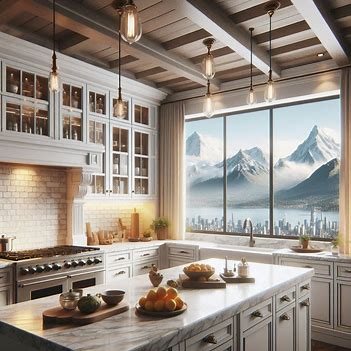Buildings and residential interiors heavily rely on granite countertops because this stone stands tall among available construction materials when it comes to being cost-effective and lasting for years. People frequently wonder which rock category granite belongs to besides seeking to understand its generation process and special attributes. But we have got you covered. This guide provides detailed information of granite including its natural geological history to its current practical applications.
What Type of Rock Is Granite?
Geologically granite belongs to the classification group of igneous rocks. Intrusive igneous classification defines Granite as an underground magma formation rock that cools very slowly over time. The slow cooling process enables granite to develop extensive crystals that create its distinctive coarse texture and special visual appearance.
Granite takes its name from the Latin word “granum” because the stone displays granular features. Granite crystals can be observed due to their slow cooling depth within the Earth. The extensive cooling time enables the prominent arrangement of quartz feldspar and mica mineral crystals to become visible.
How Is Granite Formed?
Granite needs millions of years to develop its characteristics while residing beneath Earth’s crust. Whenever magma cools slowly underground it develops crystal structures. The different minerals within the magma form distinct crystals. Granite becomes a strong sustainable rock through the bonding of its main components which consist of quartz feldspar and mica.
The formation of granite takes place inside Earth’s crust under the conditions present in regions of mountain and continental collisions. The necessary conditions for granite formation exist in areas where both elevated pressure and temperature reach their highest levels.
What Is Granite Made Of?
Granite is composed of:
- The mineral quartz in crystalline form exists in quantities between 20-60 percent and delivers durability and weathering protection to the rock.
- Most granite contains Feldspar as a main component at percentages ranging from 35 to 75 which determines its pink to white to gray color palette.
- Mica constitutes 5-15% of the rock composition consisting of muscovite or Biotite which provides black or silver crystal flakes.
- Amphiboles and other minerals contribute to texture and color variation.
Every mineral within granite brings individual coloring and properties to the rock that’s why every granite countertop slab is unique. Its special mix of minerals creates strength along with captivating appeal in granite stone.
Is Granite a Mineral?
Granite includes minerals among its elements yet it does not belong to the mineral category. Granite functions as a rock that presents itself as a solid mass which unites one or multiple mineral elements together. The unique features of granite result from its mineral composition that includes feldspar and quartz and mica.
Understanding the difference is important. Natural occurrences of inorganic substances with precise chemical and structural composition qualify as minerals while rocks appear as aggregates from one or multiple minerals.
What Type of Stone Is Granite?
The natural stone formation of granite takes place through organic geological processes. The raw material emerges from Earth to get processed into slabs. The composition of granite differs from quartz surfaces because it exists solely as a natural stone material. The natural process of granite formation remains the fundamental appeal that attracts homeowners to use it in home design. Every project receives its distinctive finish because no two granite pieces share identical characteristics. Looking for quality granite options? Visit our countertop store in Chesapeake, VA. Our Granite Collection section allows you to view multiple color and style selections.
Where Is Granite Found?
Granite can be found across all continents of the earth. The colors and patterns of granite change across different producing regions so they contribute to worldwide material diversity. Major granite-producing regions include:
- India: Renowned for its wide variety of colors and patterns.
- Brazil: Offers some of the most exotic and colorful granite in the world.
- China: One of the largest exporters of granite.
- United States: The granite production hubs in the United States are located in Vermont Georgia and South Dakota.
What Is Granite Used For?
The durability, visual attractiveness, heat-resistance, and scratch-resistance abilities give granite a wide range of possible uses. Some of the top places where you can use granite countertops are:
- Kitchen Countertops
- Bathroom Vanities
- Flooring and Tiles
- Monuments and Memorials
- Paving Stones and Outdoor Landscaping
- Fireplace Surrounds
How Does Granite Form in Nature?
The geological creation of granite occurs when rocks develop under deep crustal conditions characterized by intense heat and great pressure. Tectonic plate movements with plate collisions produce magma. Underground trapping blocks the magma until it cools down at an extremely slow rate. The molten material converts into granite after a prolonged period of many millions of years.
The extremely long period it takes granite to form makes it a rock commonly observed in mountain ranges located near plate tectonic borders. Large masses of igneous rock called batholiths contain granite since they arise from cooled underground magma.
How Are Granite Countertops Made?
The extraction process for granite blocks from quarries involves employing wire saws and heavy equipment for the removal task. After obtaining the rock below is written how it is converted into granite countertops.
- Slab production happens through cuts of granite blocks implemented by gang saws and multi-blade saws.
- A finishing process provides slabs with complete exposure to their original aesthetic appearance through surface polishing.
- Accurate dimensional measurements are obtained from the future installation area of the countertop.
- The fabrication process includes several steps such as size cut and the addition of features for sink openings and edge modifications.
- The surface obtains a protective sealant as a stain prevention method.
- After finishing the piece technicians install it and use adhesives for assembly.
Final Thoughts: Why Choose Granite?
Granite diminishes to being a stone yet represents a stone that unites durability with its attractive appearance along with its ancient earth heritage. Each granite slab exists as a historic chronicle created over numerous millions of years during its geological development. The investment value of granite stands permanently because owners get durability together with distinct visual appeal.





